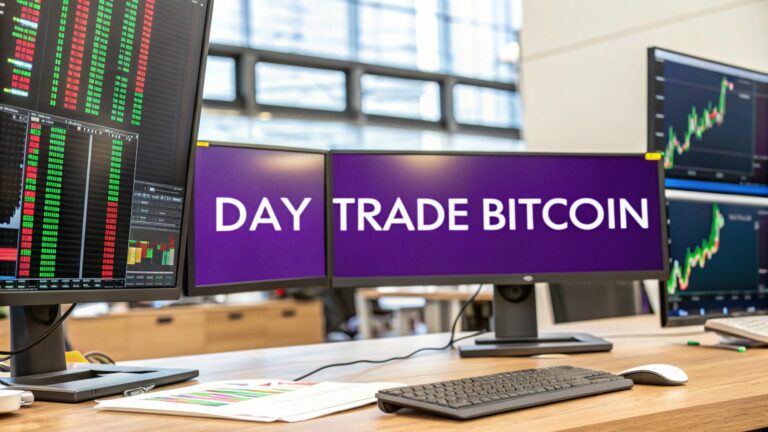Understanding Bitcoin Day Trading Fundamentals
Day trading Bitcoin offers a unique blend of excitement and challenge, a departure from traditional "buy and hold" investing. What separates consistently profitable Bitcoin day traders from those who lose their capital? It comes down to strategy, discipline, and a thorough understanding of the market. You might find this helpful: How to start trading cryptocurrency.
Bitcoin's 24/7 Market: A Double-Edged Sword
Unlike traditional stock markets with set trading hours, the Bitcoin market operates 24/7. This offers continuous opportunities, but also demands constant awareness. This around-the-clock trading allows you to capitalize on price fluctuations occurring at any time. However, it also means significant market movements can happen while you're asleep, highlighting the importance of strong risk management.
The Psychology of Successful Bitcoin Trading
Successful Bitcoin day trading requires a particular mindset. Emotional decisions are often a trader's downfall. Fear and greed can trigger impulsive actions, leading you astray from your plan. Developing discipline and emotional control are essential. This allows you to execute your strategy effectively and reduce emotionally driven losses. This demands patience, discipline, and adherence to a predefined trading plan.
Trading Styles: Finding Your Fit
Various day trading styles exist, each with its own approach to timing and risk:
- Scalping: This focuses on small price changes over short periods, demanding rapid execution and precise timing. It's about making small, frequent gains.
- Day Trading: This involves holding positions for a few hours, aiming to capitalize on intraday price swings. It requires analyzing trends and anticipating market movements within a single trading day.
- Swing Trading: This involves holding positions for several days to capture larger price swings. This approach demands more patience and a greater risk tolerance.
Choosing the right style depends on your personality, risk tolerance, and available time. Scalping requires constant attention, while swing trading allows for more flexibility. Aligning your trading style with your personal circumstances is key to long-term success.
Day trading Bitcoin, like any financial market, involves managing risk and understanding probability. Bitcoin's high volatility can be appealing, but success rates in day trading are generally low. Quantified Strategies offers more detailed statistics. Often, only a small percentage of traders consistently profit due to emotional decisions, lack of strategy, and overtrading. A solid trading plan and effective risk management are therefore crucial. This understanding will shape your trading approach and help establish realistic expectations.
Choosing the Right Trading Platforms and Tools
Your Bitcoin day trading success depends heavily on choosing the right platform and tools. A bad choice won't just lose you money; it will lose you valuable opportunities. It's more than just picking a platform with a nice interface. It's about understanding the features that truly empower day traders.
Essential Platform Features for Bitcoin Day Trading
Effective Bitcoin day trading requires a platform offering speed, reliability, and features designed for active trading. These features distinguish amateur platforms from professional ones:
-
Low Latency Order Execution: Fast order execution is crucial in the fast-paced world of Bitcoin day trading. Every millisecond matters, and slow execution can separate a profitable trade from a missed opportunity.
-
Advanced Charting Tools: Strong charting tools are essential for technical analysis. Look for platforms offering various indicators, drawing tools, and customizable chart layouts.
-
Real-Time Market Data: Access to real-time market data, including order books and trade history, is critical for informed decisions. This lets you react to market changes and adjust your strategy.
-
Secure API Integration: For automated trading or using third-party analysis tools, secure API access is vital. This connects your trading platform to other software and automates parts of your trading strategy.
Top Bitcoin Day Trading Platforms
Several platforms excel at providing these key features:
-
Binance: Known for its wide selection of cryptocurrencies and high liquidity. Binance
-
Coinbase Pro: Offers a more professional trading interface and lower fees than standard Coinbase. Coinbase Pro
-
Kraken: A respected exchange focused on security and advanced order types. Kraken

The infographic above shows a trader using a multi-monitor setup with a Bitcoin trading platform. It highlights the importance of a well-configured trading environment. The key takeaway is setting up your platform effectively to monitor markets and execute trades efficiently. To minimize costs and maximize returns, you might be interested in: Cheapest Way to Buy Crypto.
Essential Trading Tools: Beyond the Platform
Beyond the trading platform, other tools can significantly improve Bitcoin day trading performance:
-
TradingView: This platform offers powerful charting tools, technical analysis indicators, and a social community for sharing trading ideas. It lets you analyze Bitcoin’s price action in detail. TradingView
-
Portfolio Management Software: Tracking your trades, profits, and losses is essential for strategy improvement. Dedicated portfolio management software can automate this. This helps you identify your trading approach's strengths and weaknesses.
-
Automated Trading Bots: Bots can automatically execute trades based on pre-defined rules, saving you time and removing emotional biases. Use them cautiously and with thorough testing.
Hidden Costs and Multiple Accounts
Be aware of hidden trading costs. These can include:
-
Spread Differences: The difference between buy and sell prices varies between platforms, impacting profitability.
-
Withdrawal Fees: Moving your Bitcoin off the exchange can incur fees that reduce profits.
Consider setting up accounts on multiple exchanges. This strategy offers several benefits:
-
Arbitrage Opportunities: Capitalize on price differences between exchanges by buying Bitcoin where it's cheaper and selling where it's more expensive.
-
Risk Management: Diversifying funds across multiple platforms mitigates the risk of exchange outages or security breaches.
The following table compares several popular Bitcoin trading platforms. It highlights key features, fees, and security considerations to help you make an informed decision.
Bitcoin Trading Platform Comparison
| Exchange | Trading Fees | Advanced Features | Security Rating | Best For |
|---|---|---|---|---|
| Binance | 0.1% | Futures, Margin Trading, Staking | High | Experienced Traders, Altcoin Traders |
| Coinbase Pro | 0.5% – 0.04% (volume-based) | Limit Orders, Stop Orders | High | Beginners, US-Based Traders |
| Kraken | 0.16% – 0.26% (volume-based) | Margin Trading, Futures, Staking | High | Security-conscious Traders, Margin Traders |
This table provides a quick overview. It’s important to research each platform further to determine the best fit for your individual needs.
By carefully selecting your trading platform and using the right tools, you can create a trading environment optimized for success. This foundation is crucial for navigating the complexities of Bitcoin day trading and making informed decisions.
Reading Market Trends and Volume Like a Pro
Bitcoin's price is influenced by a multitude of factors. Understanding these forces is key to effective day trading. This means going beyond basic price charts and considering broader market influences.
Connecting Bitcoin to Traditional Markets and News
Bitcoin, although a unique asset, often reacts to traditional market trends and significant news. For example, global economic uncertainty can lead investors to Bitcoin as a potential safe haven. Regulatory announcements also play a major role. Positive news about institutional Bitcoin adoption can drive prices up, while negative news can trigger sell-offs. Recognizing these connections can help anticipate Bitcoin's likely reactions.
Volume Analysis: Measuring the Strength of a Move
Volume analysis is essential for evaluating the strength of price movements. High volume with a price increase suggests strong momentum, while low volume could indicate a temporary fluctuation. For successful Bitcoin day trading, understanding historical volume changes is vital. On April 27, 2020, Bitcoin's daily trading volume hit $45.2 billion, a high point in its trading history. This surge was largely due to global economic uncertainty during the COVID-19 pandemic. By October 26, 2020, volume remained high at $31.2 billion, showing sustained interest. However, these volumes can fluctuate, decreasing during market downturns, like on July 26, 2021, when the volume dropped to $33.4 billion. More detailed statistics are available here: Bitcoin Statistics. This data provides valuable context for current volume levels and helps anticipate potential trend reversals.
Uncovering Hidden Insights: Sentiment, Whales, and Exchange Flow
Beyond traditional indicators, other data points can offer valuable insights for day traders:
-
Social Media Sentiment: Monitoring platforms like Twitter can offer a real-time sense of market sentiment towards Bitcoin. While not perfect, shifts in sentiment can sometimes precede price movements.
-
Whale Wallet Movements: Tracking large Bitcoin wallets (known as "whale wallets") can reveal significant buying or selling activity by major holders. These large transactions can impact price, particularly in the short term.
-
Exchange Flow Data: Analyzing Bitcoin flow into and out of exchanges can reveal accumulation (buying) or distribution (selling) patterns. Net inflow might suggest positive sentiment, while net outflow could signal a potential price drop. More on market trends can be found here: ChatGPT – Your Guide to Decoding Crypto Market Trends in 2025.
Avoiding Information Overload
Staying informed is important, but avoiding information overload is equally crucial. Focus on a select group of reliable data sources and indicators that you understand. Create a routine for analyzing market trends and volume that suits your trading style and time. This focused approach promotes informed, effective decision-making. By combining these techniques, you can gain a comprehensive understanding of market forces and an advantage over traders who rely solely on price charts.
Mastering Technical Analysis for Bitcoin Trading

Technical analysis for Bitcoin day trading demands a different approach compared to traditional assets. Generic strategies often fall short in the crypto market's volatile environment. This requires adapting your analysis to Bitcoin's specific characteristics.
Bitcoin-Specific Chart Patterns and Indicators
Bitcoin, while sometimes influenced by broader market trends, often displays unique chart patterns. Recognizing these patterns is key for successful day trading. For instance, the "Bart Simpson" pattern, characterized by a rapid rise and fall resembling the cartoon character's hair, is a common occurrence in Bitcoin.
Furthermore, standard indicators require a different interpretation in the context of Bitcoin's volatility. These include Moving Averages, RSI (Relative Strength Index), MACD (Moving Average Convergence Divergence), and Bollinger Bands. For those new to these indicators, Simplifying Crypto Trading: Essential Indicators for Beginner Investors offers a helpful introduction.
Timeframes: From Scalping To Trend Confirmation
The timeframe you select significantly impacts your trading strategy. 1-minute charts are commonly used for scalping, aiming to profit from small price fluctuations. 5-minute and 15-minute charts are popular for short-term day trades.
4-hour charts, on the other hand, help confirm broader trends. They also help identify potential entry and exit points. Understanding the significance of each timeframe is vital for developing a consistent trading approach.
Identifying Breakout Opportunities and False Signals
Breakouts, where Bitcoin's price moves decisively through support or resistance levels, can offer lucrative opportunities. However, false breakouts, also known as “fakeouts,” can trap traders. Learning to distinguish between genuine and false breakouts is crucial for minimizing losses. This involves analyzing volume and confirming breakouts across multiple timeframes.
Confluence-Based Trading: Increasing Your Win Rate
Combining multiple technical indicators creates what's known as confluence. When several indicators suggest the same trade direction, it increases the likelihood of a successful outcome. Research indicates that traders using multiple timeframe analysis achieve 67% higher accuracy.
Confluence-based setups (using 3+ indicators) result in 2.3x better risk-reward ratios compared to single-indicator strategies. More detailed statistics can be found here: https://example.com/bitcoin-technical-analysis-study. This data highlights the potential of confluence-based trading.
Practical Templates and Systematic Approaches
Developing systematic approaches is essential for consistent Bitcoin day trading. Create chart templates with your chosen indicators and timeframes. Also, establish clear entry and exit rules.
This structured framework will streamline your trading process. It also helps manage emotions and avoid impulsive decisions. A systematic, methodical approach can improve trading accuracy and overall returns in the dynamic Bitcoin market.
Building Bulletproof Risk Management Systems

Risk management in Bitcoin day trading goes beyond simply setting stop-loss orders. It's about constructing a robust system to safeguard your capital while maximizing profit potential in this volatile market. This systematic approach empowers you to navigate Bitcoin's price fluctuations with calculated precision, proving crucial for your long-term success.
Position Sizing: Calculating Your Bitcoin Trade Size
A critical aspect of risk management is position sizing. This involves determining the appropriate amount of Bitcoin to trade based on your risk tolerance and prevailing market conditions. Consider Bitcoin’s daily volatility range when calculating these trade sizes.
For example, if Bitcoin typically fluctuates by 5% daily, you might limit your trade size to a percentage of your capital that reflects your comfort level with that potential swing. A smaller position size reduces potential losses. Conversely, a larger position size amplifies both gains and losses.
The Psychology of Sticking to the Rules
Adhering to risk management rules, especially during periods of high emotional intensity, can be difficult. Fear and greed can often cloud judgment, potentially leading to impulsive and detrimental decisions. Experienced traders emphasize the importance of pre-defined rules and emotional detachment. Check out our guide on How to master trading psychology.
This involves setting clear entry and exit points before entering a trade and requires disciplined execution, regardless of short-term market fluctuations. This disciplined approach helps protect against emotional decision-making.
Advanced Risk Management Techniques for Bitcoin
Beyond basic stop-loss orders, consider exploring these more advanced techniques:
-
Trailing Stops: These automatically adjust your stop-loss as the price moves favorably, locking in profits while still allowing for further gains. This dynamic approach helps maximize profits while mitigating potential downturns.
-
Hedging Strategies: Consider hedging your Bitcoin positions using correlated assets. This can help offset potential losses in Bitcoin. For instance, if you anticipate a temporary Bitcoin downturn, you might consider shorting a Bitcoin futures contract.
-
Managing Multiple Positions: When day trading multiple Bitcoin positions, be mindful of overexposure to market risk. Diversify your trades across different assets or trading strategies to reduce your portfolio's vulnerability to sudden price changes.
Analysis of 50,000 Bitcoin day trading accounts reveals that traders implementing strict risk management rules (maximum 2% risk per trade) have a 78% higher survival rate after 12 months. Consistent position sizing leads to 3.4x better long-term returns despite lower individual trade profits. Explore this topic further: Bitcoin Risk Management Study.
Navigating Bitcoin-Specific Risks
Bitcoin presents unique risks that require specific risk management strategies:
-
Weekend Gaps: Bitcoin trades 24/7, which means price gaps can occur over weekends when traditional markets are closed. Set wider stop-loss orders to accommodate these potential gaps.
-
Exchange Outages: Cryptocurrency exchanges can experience technical issues or downtime, potentially hindering your ability to exit trades. Diversify across multiple exchanges to mitigate this risk.
-
Regulatory Announcements and Network Congestion: Regulatory news and network congestion can significantly impact price volatility and transaction processing times. Factor these considerations into your risk assessments.
By developing a robust risk management system tailored to Bitcoin day trading, you can protect your capital, manage emotional responses, and navigate the challenges of this dynamic market effectively. This systematic approach forms the bedrock of sustainable trading and long-term success.
Navigating Cryptocurrency Market Dynamics
Bitcoin's price is deeply connected to the overall cryptocurrency market. Understanding this connection is key for successful day trading. It helps you anticipate market shifts and time your trades effectively.
Bitcoin Dominance and Altcoin Performance
Bitcoin dominance, the percentage of the total crypto market cap held by Bitcoin, significantly impacts altcoin performance. When Bitcoin dominance is high, investment tends to flow towards Bitcoin, often leaving altcoins behind.
Conversely, when Bitcoin dominance drops, investment may shift into altcoins, potentially boosting their prices. Recognizing these shifts can reveal opportunities in both Bitcoin and altcoin markets. For example, declining Bitcoin dominance might be a good time to consider day trading strong altcoins.
Bitcoin as a Safe Haven and Risk-On Asset
Bitcoin can function as both a safe haven and a risk-on asset. During uncertain times, investors may flock to Bitcoin as a store of value, similar to gold. This can increase Bitcoin demand and price.
However, during periods of higher risk tolerance, Bitcoin can also lead market rallies, pulling altcoins along with it. Understanding these market dynamics is essential for discerning whether Bitcoin is driving or reacting to market sentiment.
Institutional Adoption, Regulation, and Macro Factors
Institutional adoption of Bitcoin, regulations, and macroeconomic factors create predictable patterns in the crypto market. Positive news about institutional Bitcoin investment can spark market-wide rallies. Similarly, regulatory clarity or favorable economic conditions can boost investor confidence and drive up crypto prices.
The success of Bitcoin day trading is affected by wider crypto market trends. The overall crypto market has experienced significant trading volume shifts. From July 1, 2020, to March 21, 2025, global crypto trade volume fluctuated substantially, reflecting changing investor sentiment and market conditions. The entire crypto market's daily trade volume has varied greatly, influenced by factors like Bitcoin's price and developments in other cryptocurrencies like Ethereum. Understanding these broader market dynamics is essential for informed decisions. Find more detailed statistics here: Cryptocurrency Trade Volume.
Arbitrage Opportunities and Market Correlation
Price differences for Bitcoin on different exchanges can create arbitrage opportunities. This involves buying Bitcoin on one exchange where it's cheaper and simultaneously selling it on another where the price is higher. However, it's important to consider transaction fees and transfer times to ensure profitability.
Understanding market correlation is also crucial. Market correlation measures how closely the prices of different cryptocurrencies move together. High correlation means they tend to move in the same direction, while low correlation indicates independent price action. Using market correlation data can help diversify your portfolio and protect against sudden market-wide swings. This information allows you to adjust your trading strategies and minimize potential losses. By grasping these broader crypto dynamics, you can create more nuanced trading strategies and boost your chances of successful Bitcoin day trading.
The following table provides a historical overview of Bitcoin's performance compared to the overall cryptocurrency market under various conditions.
Bitcoin vs Cryptocurrency Market Performance
| Time Period | Bitcoin Volume | Total Crypto Volume | Bitcoin Dominance | Market Condition |
|---|---|---|---|---|
| Example 1 | Data 1 | Data 2 | Data 3 | Data 4 |
| Example 2 | Data 5 | Data 6 | Data 7 | Data 8 |
| Example 3 | Data 9 | Data 10 | Data 11 | Data 12 |
This table uses placeholder data for illustrative purposes. Real market data would be needed for accurate analysis.
This table highlights the complex interplay between Bitcoin's performance, overall market volume, and its dominance. Analyzing these relationships can offer valuable insights for day traders seeking to capitalize on market fluctuations.
Your Action Plan for Bitcoin Day Trading Success
Theory without action won't generate profits. This section provides a practical roadmap to safely and effectively begin your Bitcoin day trading journey. We'll cover a step-by-step guide and offer essential tips for long-term success.
Setting Up Your Trading Environment
Your first step is creating a secure trading account on a reputable cryptocurrency exchange. Choose a platform that matches your trading style and offers the tools you need, such as low latency order execution and advanced charting.
-
Choose Your Exchange: Consider factors like fees, security, and available features when selecting an exchange like Binance, Coinbase Pro, or Kraken.
-
Enable Two-Factor Authentication (2FA): This crucial security measure adds an extra layer of protection to prevent unauthorized access.
-
Practice on a Demo Account: Familiarize yourself with the platform and test strategies risk-free using a demo account with virtual funds.
-
Start Small: Begin with a small initial deposit to limit potential losses while learning. Increase your trading capital gradually as you gain experience and confidence.
Daily Trading Routine Checklist
A consistent routine is crucial for disciplined Bitcoin day trading. This helps you avoid impulsive decisions and encourages a methodical approach.
-
Pre-Market Analysis: Analyze market trends, news, and volume to identify potential trading opportunities and plan your strategy.
-
Trade Execution Protocol: Define clear entry and exit points for your trades. Stick to your plan and avoid emotional decisions based on short-term fluctuations.
-
End-of-Day Performance Review: Review your wins and losses to identify areas for improvement and refine your strategy.
Record-Keeping and Performance Tracking
Accurate records of your trades are crucial for tax purposes and performance analysis. Track your progress and identify patterns in your trading activity.
-
Trading Journal: Log every trade, including entry and exit points, trade size, and your rationale. This journal offers valuable insights into your decisions.
-
Tax Software: Consider using cryptocurrency tax software to simplify calculating and reporting profits and losses for tax compliance.
Realistic Profit Expectations and Scaling Your Trading
Especially as a beginner, have realistic profit expectations. Bitcoin day trading is not a get-rich-quick scheme. Focus on consistent small gains. Gradually scale your trading activity as you gain experience and confidence for sustainable growth and managed risk.
Common Beginner Mistakes and Warning Signs
Be aware of common beginner mistakes: overtrading, emotional decision-making, and chasing losses. Recognizing these pitfalls helps you avoid them. Watch for signs of overtrading like constantly checking charts, neglecting responsibilities, or experiencing trading-related anxiety. Take a break and reassess your approach if needed.
Continued Learning and Mentorship
Bitcoin day trading is a continuous learning process. Seek additional education through online resources, books, or courses. A mentor or trading community can provide valuable support and accelerate your learning from experienced traders.
Ready to begin your Bitcoin day trading journey? Join vTrader, the commission-free cryptocurrency exchange. Trade Bitcoin, Ethereum, and over 30 altcoins with zero fees. Access advanced trading tools, real-time market data, and a seamless trading experience. Start trading with vTrader now!

Steve Gregory is a lawyer in the United States who specializes in licensing for cryptocurrency companies and products. Steve began his career as an attorney in 2015 but made the switch to working in cryptocurrency full time shortly after joining the original team at Gemini Trust Company, an early cryptocurrency exchange based in New York City. Steve then joined CEX.io and was able to launch their regulated US-based cryptocurrency. Steve then went on to become the CEO at currency.com when he ran for four years and was able to lead currency.com to being fully acquired in 2025.


